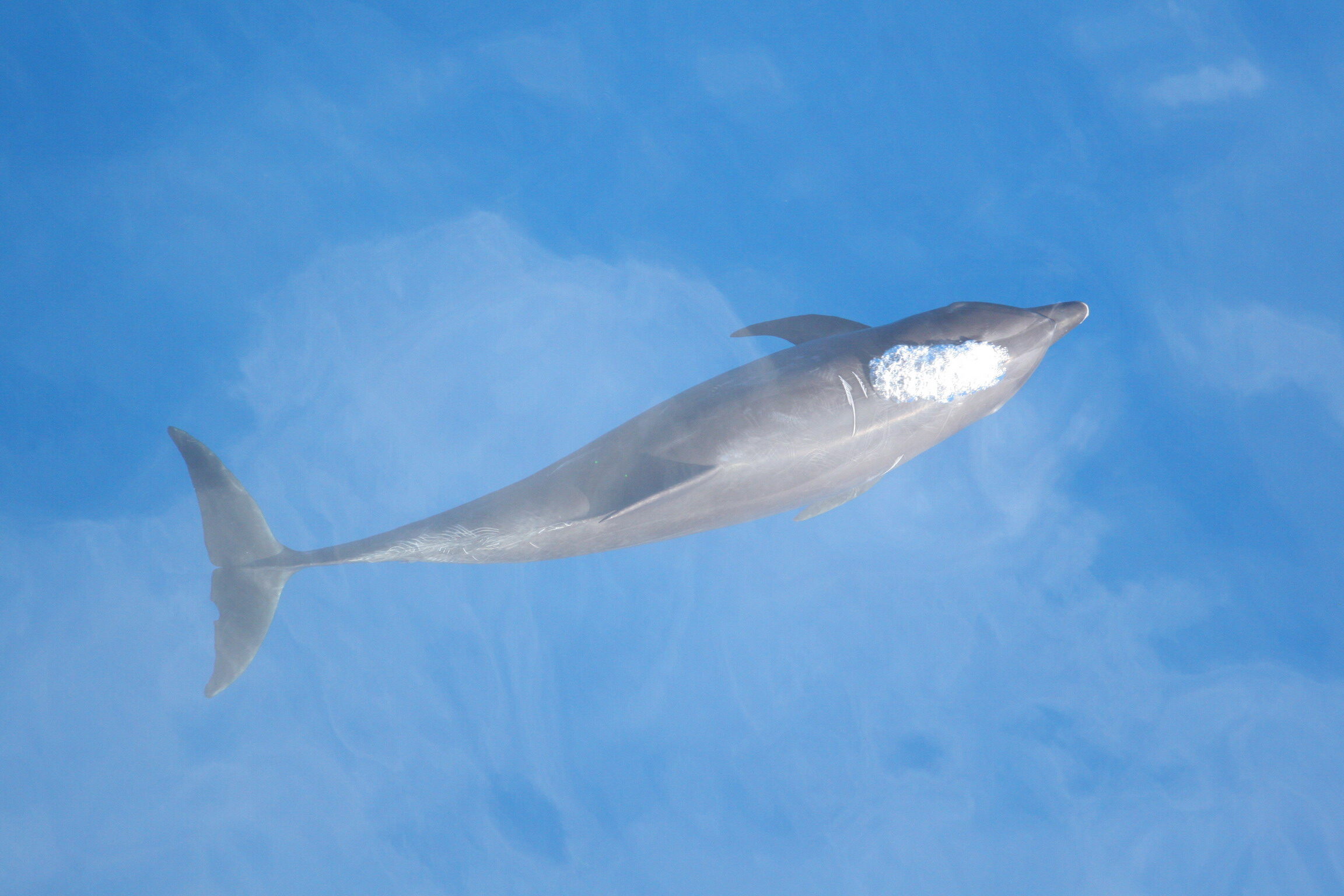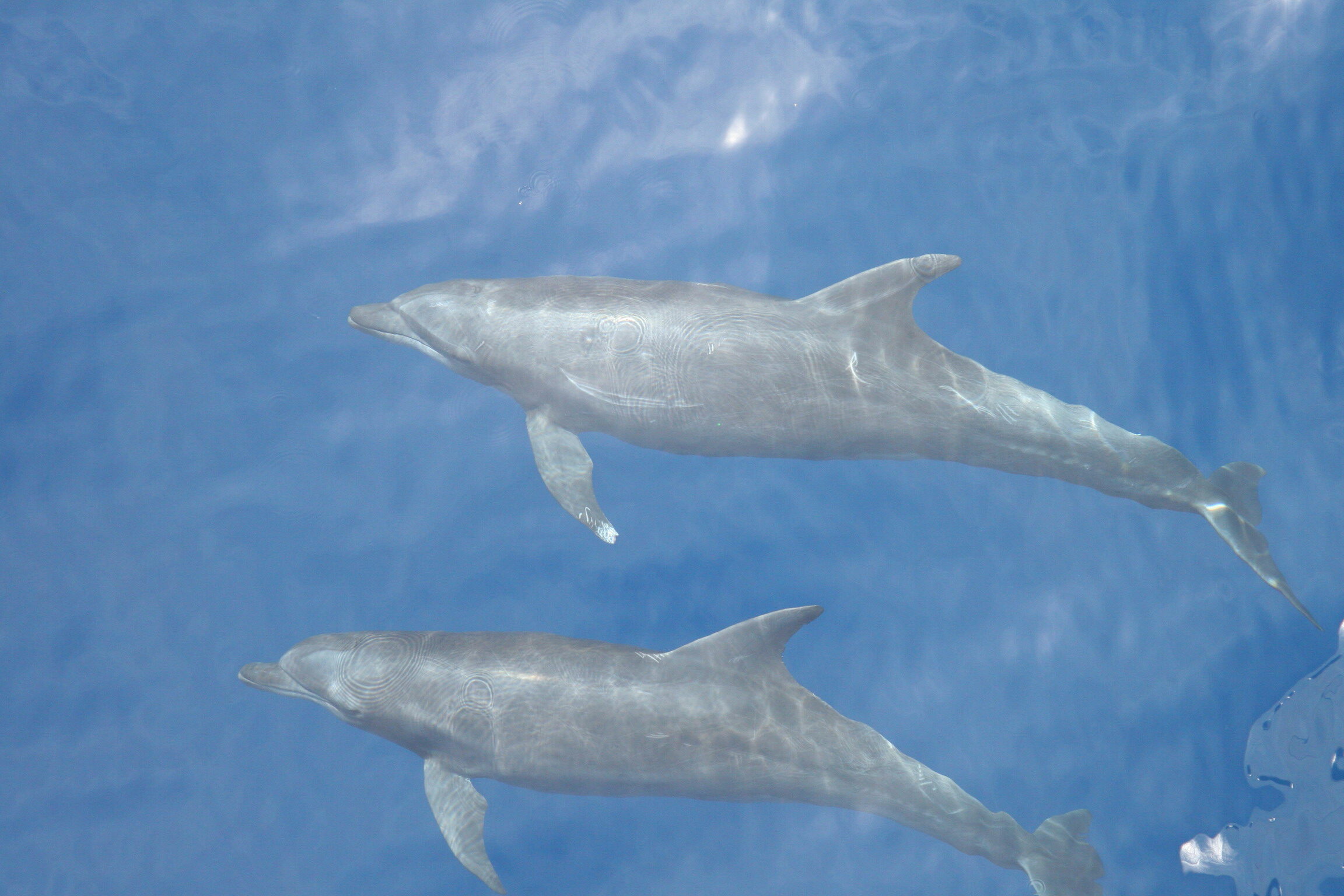
An analysis of several specimens conducted by Ana Costa — a marine researcher with the Rosenstiel School of Marine, Atmospheric, and Earth Science at the University of Miami — and colleagues found that the new subspecies is smaller than other common bottlenose dolphins.
In a study published in the Journal of Mammalian Evolution, the scientists named the new subspecies the Eastern Tropical Pacific (ETP) bottlenose dolphin, or Tursiops truncatus nuuanu in scientific terms.
Common bottlenose dolphins are found in temperate, subtropical, and tropical oceans around the world, with the global population estimated to number around 600,000 individuals.
These dolphins, which are highly intelligent creatures, grow to between 6.5 and 13 feet in length, and can weigh more than 1,000 pounds. Their name is a reference to their short, thick snout, or rostrum.
While the common bottlenose dolphin is considered a single species (Tursiops truncatus), in some locations, scientists have observed distinct populations that have differing ecological and habitat preferences.
Costa told Newsweek these distinct preferences can lead to differences in genetics or form, potentially separating populations found in the same region into what scientists call ecotypes (a distinct population of a species that is adapted to local conditions) and even leading to speciation — the evolutionary process by which populations evolve to become distinct species.
For example, Costa and her colleagues from the National Oceanic and Atmospheric Administration (NOAA) — Patricia Rosel with the Southeast Fisheries Science Center (SEFSC) and Eric Archer with the Southwest Fisheries Science Center (SWFSC) — showed in previous research that two ecotypes of bottlenose dolphin that live along the U.S. Atlantic coast were different enough when it comes to genetics and form to be described as distinct species.
Based on their findings, the scientists proposed that one ecotype of the U.S. Atlantic bottlenose dolphin, which prefers shallow waters, be recognized as a new species, Tursiops erebennus (Tamanend's bottlenose dolphin), whereas the other, which tends to be found in deeper, offshore waters, continue to be referred to as the globally distributed Tursiops truncatus (common bottlenose dolphin).
Along the U.S. Pacific coast, more specifically along the coast of California, two common bottlenose dolphin ecotypes have been identified, Costa said. Previous studies in the eastern Pacific Ocean, including in California, revealed differentiation between common bottlenose dolphin populations. However, these were conducted in localized areas.
A distinct form of bottlenose dolphin was also suggested for the eastern tropical Pacific in the early 1900s, but it was based on only a few specimens and field records, according to the researcher.
"Thus, despite the previous studies in the area, there was a need to better characterize the level of differentiation between these different populations and determine whether there was, in fact, a distinct bottlenose dolphin form in the eastern tropical Pacific," Costa said.
In order to do this, Costa, Rosel and Archer collaborated with the late researcher William Perrin at the SWFSC, who passed away in July this year, to conduct a broader study with the aim of better understanding the taxonomy of common bottlenose dolphins in this region.
For the Mammalian Evolution paper, the researchers examined the skulls of more than 130 bottlenose dolphin specimens from both the eastern Pacific and western North Pacific — off the shores of Japan — that are held in museum collections across the United States. In some cases, the team also looked at the total body length of these specimens.

"The bottlenose dolphins found in offshore waters of the eastern tropical Pacific formed one single cluster, and they were significantly smaller — based on skull and body length — than common bottlenose dolphins forming the other cluster," Costa said. "Our findings indicated that the offshore bottlenose dolphins of the eastern tropical Pacific are speciating from the globally distributed common bottlenose dolphins and should be described as a different subspecies."
The new subspecies is restricted to the eastern tropical Pacific, and likely has a preference for deeper, offshore waters between southern Baja California and the Galápagos Islands.
Costa said the differentiation of the ETP bottlenose dolphins from other common bottlenose dolphins could be the result of the environment they occupy. For example, the distinct environmental conditions in the eastern tropical Pacific and potential variations in feeding behaviors may be influencing the differentiation.
"The specimens in this subspecies are one of the smallest common bottlenose dolphins found," Costa said. "Dolphins are a charismatic fauna, and it is common for the public to think that all dolphin species are already known. However, with the improvement of technologies and integration of different methodologies, as well as the increase in samples from different areas, greater biodiversity has been revealed in more recent years."
The results of the latest study could have have implications when it comes to protecting these animals.
"By better understanding the biodiversity in the ocean, we can better understand the relationship of the dolphins with their environment and the threats they face, and in this way better define conservation and management strategies," Costa said.



Reader Comments
If you take a mammal, seperate it from the larger group of its own kind, maybe it happens naturally due to cataclysm in its enviroment, which creates a genetic bottleneck in regards to it's ability to procreate (perhaps producing an enviroment where a reduction in availible mates causes inbreeding depression or food becomes limited causing generational changes in the mammals morphology like vigor decline or optimal health decline due to enviromental stresses, like proven in the 17th century when man began breeding animals regularly, becomes evidence of "evolution"???
If you have ever been to England you might of seen very old houses have very small front doors, which reflects the size of the people that used to live at the time of its build, this is not because humans are evolving into taller people, it's relative to the enviromental stresses of that period, people are taller because they have access to more food, they live longer due to breakthroughs in sanitation, healthcare, for a while at least enjoyed access to land and all of this created nearer to optimal health which offers the best physiology, compare the people from the last industrial revolution where enviromental stresses and inadequate access to food, medicine and winter heat rendered these people significantly shorter (with reflective longevity) ....but it's not evolving, if anything it's the opposite, imho.
What next...
Spiders, that to survive earth changes began living in dark crevices in caves that see no direct sunlight, thus losing the use over time of its eyes....is recorded as evolving eyes from scratch....just not yet functioning the same as its closest relatives that stayed above ground....it's just science loves to dictate "what is" but that still requires trust.
Science is so full of shit and so is this evolution lie.
To suppose that the eye with all its inimitable contrivances for adjusting the focus to different distances, for admitting different amounts of light, and for the correction of spherical and chromatic aberration, could have been formed by natural selection, seems, I freely confess, absurd in the highest degree.
A system performing a given basic function is irreducibly complex if it includes a set of well-matched, mutually interacting, nonarbitrarily individuated parts such that each part in the set is indispensable to maintaining the system's basic, and therefore original, function. The set of these indispensable parts is known as the irreducible core of the system.
a single system composed of several well-matched, interacting parts that contribute to the basic function, wherein the removal of any one of the parts causes the system to effectively cease functioning.